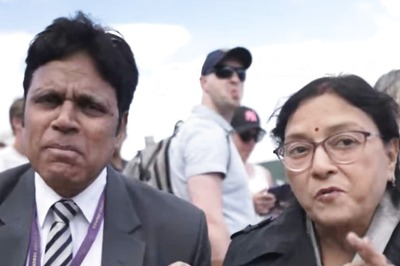
views
The rise of China’s technological growth has created ripples in the world technology ecosystem.
The global tech markets, which were generally dominated by the West have come under immense geopolitical and geoeconomic pressure due to China’s rapid growth in developing emerging technologies. The Chinese government has created a vision for the State to dominate the global tech supply chains and eventually concentrate geopolitical power. At the heart of this vision lies technical standards and the role they play in determining the balance of power between technologically adept states.
Beijing’s view on economic and technical growth has a simple saying: Third-tier companies make products. Second-tier companies make technology. Top-tier companies set standards. China wants to take over the mantle of the latter. With this in mind, the Chinese government revealed the ‘China Standards 2035’ project in 2020, which emphasises the role of technical standards in creating political and economic value for the state. One of the flagship schemes of China for the coming decade, the ‘Standards 2035’ project aims to control the governing mechanism of strategic technologies like 5G, Artificial Intelligence (AI), and Internet of Things (IoT). However, the project does not restrict itself to technology and underlines the objective of the Chinese State and state-supported companies to set standards in other sectors like agriculture and manufacturing also.
This ambitious plan of the Chinese government has ruffled feathers in the West. But the inherent objectives of setting standards provide a silver lining for those seeming to fret over their rival’s ambitions. The current geopolitical climate and the working of the Chinese government will make it incredibly difficult for them to spearhead the process of technical standard-setting. Though having both economic and political clout on the international stage, China finds it hard to convince the rest of the world to follow the governance framework they propose, especially for critical and strategic technologies.
ALSO READ | Current Wave of China’s Big Tech Crackdown Has Unnerved Investors
The Interoperability Dilemma
One of the basic requirements of an international technical standard is to ensure the interoperability of specific technology. Standards act as global frameworks to advance growth and allow easier dissemination of technology across borders. For example, in the telecommunication domain, the creation of a 4G/5G standard is to ensure an open communication network that would allow users access to other global networks.
China and its attempts to influence the standard-setting process can be seen with respect to the 5G standards. This has been done through Huawei and other state-supported telecommunication firms. With Huawei demonstrating exemplary technological advancements in the field of 5G, the company now owns the largest share of 5G related patents. This has made the Chinese and its companies effectively control the growth of 5G technology across the globe.
However, the threats of state-sponsored surveillance have made other countries take note of the effects of Chinese equipment in their networks. The United States, which has been in a major trade war with China for a year and is one of the largest markets for telecommunication companies, has now introduced a new programme to replace the existing Huawei and ZTE equipment from local networks.
The United States Federal Communications Commission (FCC) recently offered to reimburse local telecom carriers for removing network equipment made by Chinese companies citing threats to national security. While the FCC had already declared the two Chinese companies, Huawei and ZTE, as national security threats the previous year and had placed them on the blacklist, this development ensures the complete eradication of Chinese equipment and technology from the US market.
It is, however, not just the Americans who have officially placed restrictions and outright bans on Chinese telecommunication companies. The United Kingdom, after years of deliberation, decided to ban the purchase of any new 5G equipment from Huawei and ordered the existing equipment to be completely removed from local networks by 2027. The other members of the Five Eyes intelligence-sharing network, Australia, New Zealand and Canada, have also formally blocked Huawei’s presence in the local 5G infrastructure. Other countries are following suit and the Chinese telecommunication giants are losing massive market share due to these curtailments.
Sanctions and restrictions have effectively crippled Huawei and other Chinese companies’ economies. It has reduced the influence the Chinese firms have on the global 5G infrastructure considerably. These kinds of actions taken by western countries can eliminate the possibility of the world adhering to Chinese-backed standards. With effectively no presence in major markets, the standards set by Chinese firms go against the basic objective of interoperability which it must satisfy. Strict responses to the usage of Chinese technology, like bans and restrictions, can result in its technical standards becoming null and void.
ALSO READ | With Quad 5G Plan, India Will Be at the Centre of Fostering Global Technology Innovation
Addressing Safety and Quality Question
Another one of the fundamental issues that technical standards tackle is maintaining the necessary threshold of quality that a technology product or service needs to adhere to before it can be used by the general public. With different companies in multiple countries engaging in developing high-end products and services, there is bound to exist a wide array of differences across the companies’ outputs. This makes it difficult to judge the quality of each product. Technical standards can ensure that there is a level playing field in global technological competition. Innovation in the field will likely see an uptick due to standards providing a clear and precise standard to preserve. The International Standard Organisation (ISO) and its specifications help to understand the level of quality that needs to be maintained for any specific technology, product, or service.
With the concept of quality, arises the aspect of safety concerns. There have been possibilities cropping up of these technological advancements potentially infringing on human rights. Applications of technologies like AI and the possibility of genetically engineering humans raise ethical questions. International technology standards can address such ethical concerns.
The Chinese government has used its premier foreign policy project, the Belt and Road Initiative (BRI), as a method to export locally developed standards to countries that have signed deals with China on infrastructure and technology projects. International technical standards have been used as a foreign policy tool by China to increase its geopolitical and geoeconomic presence. With BRI steaming ahead in regions like Central Asia and Africa, the project has been cardinal in increasing China’s presence and leverage in often neglected regions of the world. The Chinese get to increase their investments as well as sign pacts with the BRI countries for using their technology standards. But this has led to questions being asked on what the intentions of the Chinese government are in pushing these standards.
The digital infrastructure in the continent of Africa is dominated by major Chinese firms with Huawei and ZTE leading the way. However, there have been suspicions on the quality of technology provided by these Chinese companies as well as the objective of providing high-end technology to other countries. Reports of human rights abuses along with infringement on the privacy rights of users have questioned the intentions of Chinese investments in regions like Africa. The authoritarian regime of the CCP has itself has given the impression of how much the state values individuals’ rights with crackdowns on internet content and video games.
Chinese-backed standards now face the scrutiny of ensuring the quality and the protection of individuals’ rights. This will make China’s case for pushing international technical standards through difficult, with many western countries questioning the intentions of Chinese-backed standards. This has been seen in Huawei and the telecommunications domain. It is likely that with the rise of economic protectionism, there will be further pushback against Chinese products and services.
When China itself is blatantly ignoring the basic tenets of a technical standard, its quest for becoming the leader to set global standards remains far-fetched now. But with China looking for ways to influence the standards-setting processes, this can soon change. Standards-setting processes still require global consensus and increasing Chinese ambitions have made other states re-examine their presence in the international standards domain. It will be still a while before China can effectively convince the world that it can guarantee the objectives of a global standard.
The author is a research analyst at the Takshashila Institution. The views expressed in this article are those of the author and do not represent the stand of this publication.
Read all the Latest News , Breaking News and IPL 2022 Live Updates here.




















Comments
0 comment